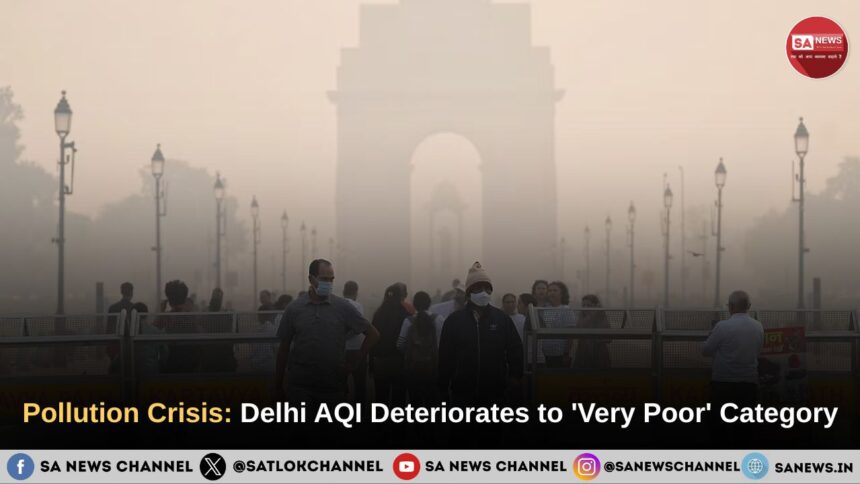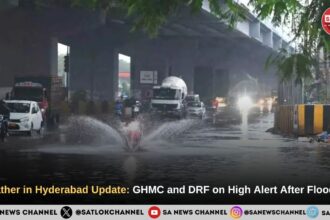Delhi AQI: The air quality in the national capital, Delhi, has plummeted back into the ‘Very Poor’ category, with the Air Quality Index (AQI) hovering alarmingly above the 300-mark for consecutive days, and in some areas, even touching ‘Severe.’ This deterioration comes despite government-led anti-pollution measures, signaling that a potent combination of stagnant wind conditions, low temperatures, and local pollutant sources continues to trap toxic smog over the city.
Experts from the Air Quality Early Warning System suggest that no significant respite is likely in the immediate future, urging vulnerable groups to avoid outdoor activities.
Delhi AQI Historical Comparison
The current pollution phase, characteristic of the post-monsoon and pre-winter months, highlights a recurring annual crisis. An analysis comparing the number of ‘Very Poor’ days in recent years reveals the persistent challenge the city faces in controlling the Delhi AQI.
Comparison of ‘Very Poor’ (AQI 301-400) Days in Delhi (Jan-Oct)
| Year | No. of ‘Very Poor’ Days (Jan-Oct) | Source |
| 2024 | 33 | CPCB historical data |
| 2023 | 21 | Tribune India article, 2023 data |
| 2022 | 21 | Times of India |
An AQI between 301 and 400 is classified as ‘Very Poor,’ which leads to respiratory illness upon prolonged exposure, according to the Central Pollution Control Board (CPCB) standards.
The period from November 1st to 15th is historically one of the most polluted fortnights in the National Capital Region (NCR), a time that typically sees:
- Peak Stubble Burning: Contribution from agricultural fires in neighboring states increases significantly.
- Adverse Meteorology: Low wind speed and lower mixing height hinder pollutant dispersion.
- Local Emissions: Vehicular exhaust, industrial emissions, and construction dust remain major contributors.
Health Advisory Amidst Delhi AQI Spike
Health experts have issued a strong advisory for Delhi-NCR residents, particularly children, the elderly, and those with pre-existing respiratory and cardiovascular conditions.
- Minimize outdoor exertion and physical activity.
- Wear N95 or P100 respirators when going out.
- Keep windows and doors closed to minimize indoor pollution.
- Use air purifiers indoors, if available.
- Monitor air quality through official CPCB sources.
The Path of Compassion and Environmental Protection by Saint Rampal Ji Maharaj
In stark contrast to the environmental negligence causing the severe Delhi AQI crisis, the teachings and actions of Saint Rampal Ji Maharaj advocate for a life free from environmental harm. His unique spiritual practice, or Satgyan, emphasizes living harmoniously with nature, ensuring that His followers strictly adhere to non-violence and do not engage in any activity that pollutes or destroys the environment.
This commitment to environmental preservation extends to selfless service, particularly through His Annapurna Muhim. A recent and profound example includes the remarkable assistance provided to farmers battling devastating floods. In villages across Haryana, Punjab, and Delhi, where fields were submerged under several feet of water, jeopardizing the vital winter crop, His followers, under His direction, swiftly mobilized the Annapurna Mission.
They installed high-powered motors, pipes, and other equipment to drain the water from the fields, effectively saving the farmers’ livelihoods and the upcoming harvest. Alongside this, regular plantation and cleanliness drives further demonstrate how Saint Rampal Ji Maharaj connects spirituality with tangible environmental stewardship. His example reminds humanity that genuine devotion to God manifests through the protection of all creation – living in harmony with nature and serving selflessly for the welfare of all.
FAQs on Delhi AQI
Q1. What is a ‘Very Poor’ AQI?
A: An AQI in the ‘Very Poor’ range (301-400) indicates that the air is severely polluted. Prolonged exposure can lead to respiratory illnesses, and even short exposure can cause discomfort and breathing difficulty, particularly for those with lung or heart diseases.
Q2. What are the main pollutants causing the high Delhi AQI?
A: The primary pollutants are PM2.5 and PM10. PM2.5 are fine particulate matter smaller than 2.5 micrometers, which can penetrate deep into the lungs and bloodstream, causing serious health issues.
Q3. What measures is the government taking?
A: The government implements the Graded Response Action Plan (GRAP), which includes measures like banning construction activities, closing down brick kilns, regulating vehicular traffic, and implementing the odd-even scheme when the AQI hits critical levels.









